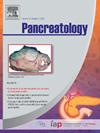Caveolin-1的表达可预测切除的胰腺导管腺癌的存活率和复发模式。
IF 2.8
2区 医学
Q2 GASTROENTEROLOGY & HEPATOLOGY
引用次数: 0
摘要
背景/目的:在癌细胞(cCav1)或癌相关成纤维细胞(fCav1)中表达的Caveolin-1(Cav1)会根据癌症类型或癌症阶段的不同发挥促进或抗肿瘤作用。我们旨在阐明 cCav1 或 fCav1 对切除的胰腺导管腺癌(PDAC)的生存、复发模式和新辅助化疗(NAC)疗效的影响:方法:构建了包括 615 例接受根治性切除的 PDAC 患者的组织芯片。采用免疫组化方法评估 Cav1 的表达。根据癌细胞(cCav1high vs. cCav1low)或癌相关成纤维细胞(fCav1high vs. fCav1low)中 Cav1 的表达将患者分为两组:与 cCav1high 相比,cCav1high 与总生存期(OS)(p = 0.001)和无复发生存期(RFS)(p = 0.001)相关性更差,并且是 OS 和 RFS 多变量分析中的独立预后因素(OS:p = 0.001,危险比 [HR] 1.361;RFS:p = 0.001,HR 1.348)。在596名可切除/边缘可切除的PDAC患者中,cCav1高的患者接受NAC治疗后的OS优于未接受NAC治疗的患者,而cCav1低的患者接受NAC治疗后的OS与未接受NAC治疗的患者无显著差异。结论:cCav1高与PDAC患者较差的生存率、早期复发和切除术后肝转移有关,而NAC可改善cCav1高患者的生存率。对 cCav1 状态的评估可为 PDAC 的个性化治疗提供更多信息。本文章由计算机程序翻译,如有差异,请以英文原文为准。
Caveolin-1 expression is a predictor of survival and recurrence patterns in resected pancreatic ductal adenocarcinoma
Background/objective
Caveolin-1 (Cav1) expressed in cancer cells (cCav1) or cancer-associated fibroblasts (fCav1) exerts either pro- or anti-tumorigenic effects depending on the cancer type or stage of cancer. We aimed to clarify the impact of cCav1 or fCav1 on survival, recurrence patterns, and efficacy of neoadjuvant chemotherapy (NAC) in resected pancreatic ductal adenocarcinoma (PDAC).
Methods
Tissue microarrays were constructed including 615 patients who underwent curative resection for PDAC. Cav1 expression was evaluated by immunohistochemistry. Patients were divided into two groups based on Cav1 expression in cancer cells (cCav1high vs. cCav1low) or cancer-associated fibroblasts (fCav1high vs. fCav1low).
Results
Among all 615 patients, 40.7% were cCav1high and 72.7% were fCav1high. cCav1high was associated with worse overall survival (OS) (p = 0.001) and recurrence-free survival (RFS) (p = 0.001) than cCav1low, and was an independent prognostic factor in multivariate analysis of OS and RFS (OS: p = 0.001, hazard ratio [HR] 1.361; RFS: p = 0.001, HR 1.348). Among 596 patients with resectable/borderline resectable PDAC, cCav1high patients with NAC showed better OS than those without, while there was no significant difference between cCav1low patients with NAC and those without. cCav1high was associated with early recurrence (< 6 months) and liver metastasis after resection. Multivariate analysis revealed cCav1high as an independent predictor of liver metastasis.
Conclusions
cCav1high correlated with worse survival, early recurrence, and liver metastasis after resection for PDAC, while NAC improved survival in cCav1high patients. The Evaluation of cCav1 status could provide additional information contributing to the personalized management of PDAC.
求助全文
通过发布文献求助,成功后即可免费获取论文全文。
去求助
来源期刊

Pancreatology
医学-胃肠肝病学
CiteScore
7.20
自引率
5.60%
发文量
194
审稿时长
44 days
期刊介绍:
Pancreatology is the official journal of the International Association of Pancreatology (IAP), the European Pancreatic Club (EPC) and several national societies and study groups around the world. Dedicated to the understanding and treatment of exocrine as well as endocrine pancreatic disease, this multidisciplinary periodical publishes original basic, translational and clinical pancreatic research from a range of fields including gastroenterology, oncology, surgery, pharmacology, cellular and molecular biology as well as endocrinology, immunology and epidemiology. Readers can expect to gain new insights into pancreatic physiology and into the pathogenesis, diagnosis, therapeutic approaches and prognosis of pancreatic diseases. The journal features original articles, case reports, consensus guidelines and topical, cutting edge reviews, thus representing a source of valuable, novel information for clinical and basic researchers alike.
 求助内容:
求助内容: 应助结果提醒方式:
应助结果提醒方式:


